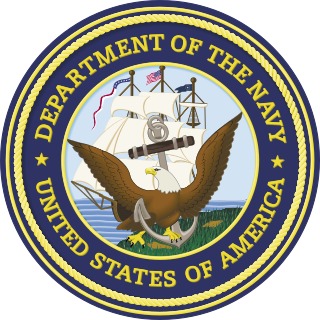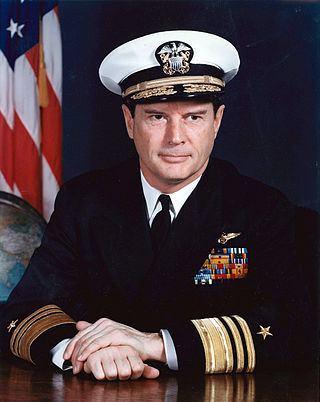Related Research Articles
Vice Admiral Thomas J. Walker was an officer of the United States Navy, who served as first commanding officer of the aircraft carrier USS Constellation.

Rear Admiral William Sterling "Deak" Parsons was an American naval officer who worked as an ordnance expert on the Manhattan Project during World War II. He is best known for being the weaponeer on the Enola Gay, the aircraft which dropped the Little Boy atomic bomb on Hiroshima, Japan in 1945. To avoid the possibility of a nuclear explosion if the aircraft crashed and burned on takeoff, he decided to arm the bomb in flight. While the aircraft was en route to Hiroshima, Parsons climbed into the cramped and dark bomb bay, and inserted the powder charge and detonator. He was awarded the Silver Star for his part in the mission.
The Bureau of Aeronautics (BuAer) was the U.S. Navy's material-support organization for naval aviation from 1921 to 1959. The bureau had "cognizance" (i.e., responsibility) for the design, procurement, and support of naval aircraft and related systems. Aerial weapons, however, were under the cognizance of the Navy's Bureau of Ordnance (BuOrd).

The AUM-N-2 Petrel, also known as Kingfisher C and AUM-2, was an air-to-surface missile produced as part of Project Kingfisher for the United States Navy. Intended for use against enemy surface ships and surfaced submarines, giving aircraft the ability to deliver aerial torpedoes from outside the range of defensive armament, it saw brief operational service in the late 1950s. The project was never considered a high priority by the Navy however, as it was useless against submerged submarines, which were considered the greatest potential threat.
The Bureau of Ordnance (BuOrd) was a United States Navy organization, which was responsible for the procurement, storage, and deployment of all naval weapons, between the years 1862 and 1959.

Admiral DeWitt Clinton Ramsey was a U.S. Navy officer and pioneer naval aviator who served as an aircraft carrier commander during World War II. His postwar assignments included command of the U.S. Pacific Fleet and service as Chief of the Bureau of Aeronautics (BuAer) in the Navy Department and as Vice Chief of Naval Operations.
The "bureau system" of the United States Navy was the Department of the Navy's material-support organization from 1842 through 1966. The bureau chiefs were largely autonomous, reporting directly to the Secretary of the Navy and managing their respective organizations without the influence of other bureaus. In 1966, the bureaus were gradually replaced by unified commands reporting to the Chief of Naval Operations.

Vice Admiral Paul David Stroop was an officer of the United States Navy and a Naval Aviator. He held numerous high-ranking staff positions in aviation from the 1930s onward, including World War II service on the staff of the Chief of Naval Operations. During the late 1940s and early 1950s, he held various sea commands. From 1959 to 1962, he oversaw the development of the Navy's aerial weapons, including early guided missiles, as chief of the Bureau of Naval Weapons. During the later 1960s, he commanded Naval air forces in the Pacific.
The United States Navy's Bureau of Ships (BuShips) was established by Congress on 20 June 1940, by a law which consolidated the functions of the Bureau of Construction and Repair (BuC&R) and the Bureau of Engineering (BuEng). The new bureau was to be headed by a chief and deputy-chief, one selected from the Engineering Corps (Marine Engineer) and the other from the Construction Corps (Naval Architect). The chief of the former Bureau of Engineering, Rear Admiral Samuel M. "Mike" Robinson, was named BuShips' first chief, while the former chief of the Bureau of Construction & Repair, Rear Admiral Alexander H. Van Keuren, was named as BuShips' first Deputy-Chief. The bureau's responsibilities included supervising the design, construction, conversion, procurement, maintenance, and repair of ships and other craft for the Navy; managing shipyards, repair facilities, laboratories, and shore stations; developing specifications for fuels and lubricants; and conducting salvage operations.

The Naval Air Warfare Center Training Systems Division (NAWCTSD) is an Echelon IV command of the United States Navy, reporting to the Commander, Naval Air Warfare Center - Aircraft Division (NAWCAD) at NAS Patuxent River, Maryland. NAWCTSD is located in Orlando, Florida in the Central Florida Research Park, adjacent to the University of Central Florida (UCF). The facility is a part of a larger military installation within the Central Florida Research Park known as Naval Support Activity Orlando.

Naval Air Station Sanford was a naval air station of the United States Navy in Sanford, Florida, approximately 20 miles north of Orlando, Florida. Opening less than a year after the start of World War II, NAS Sanford's initial function was as an advanced training base for land-based patrol bombers, followed by carrier-based fighter aircraft. The air station briefly closed in 1946 and was placed in caretaker status until being reactivated in 1950. It eventually served as a Master Jet Base for carrier-based heavy attack and reconnaissance aircraft until 1969. After its closure, it reopened as civilian general aviation airport under various names with a non-Navy civilian airport identifier until finally transitioning to a scheduled air carrier airport under its current name of Orlando-Sanford International Airport.

Vincent Paul de Poix was a vice admiral in the United States Navy. He began his career as a naval aviator and fighting in World War II aboard USS Enterprise (CV-6). A graduate of the United States Naval Academy, he became the first captain of the newly commissioned USS Enterprise (CVN-65) in November 1961. He later participated in the Vietnam War, and commanded the United States Second Fleet. He was Director of the Defense Intelligence Agency from August 1972 to September 1974.

The Kaiser-Fleetwings XBTK was an American dive and torpedo bomber developed by Kaiser-Fleetwings for the United States Navy starting in 1944. After only five examples had been built, with the first two being flying prototypes; the contract was terminated in September 1946.

The Assistant Secretary of the Navy (AIR) was a civilian office of the United States Department of the Navy. The Assistant Secretary of the Navy (AIR) initially reported to the Assistant Secretary of the Navy and later to the Under Secretary of the Navy.

The Piper LBP was a glide bomb, or "Glomb", developed by Piper Aircraft for the United States Navy during World War II. Developed as one of three "Glomb" aircraft, the inherent limitations of the Glomb and the technology of the time, combined with difficulties encountered in testing of the prototype, led to the production contract for the LBP-1 being reduced, then cancelled, with none of the Glomb aircraft ever seeing operational service.

Air Development Squadron Six was a United States Navy Air Development Squadron based at McMurdo Station, Antarctica. Established at Naval Air Station Patuxent River, Maryland on 17 January 1955, the squadron's mission was to conduct operations in support of Operation Deep Freeze, the operational component of the United States Antarctic Program.

Antarctic Development Squadron Six was a United States Navy air test and evaluation squadron based at Naval Air Station Point Mugu, California with forward operating bases at Christchurch, New Zealand and McMurdo Station, Antarctica.

The PTV-N-2 Gorgon IV was a subsonic ramjet-powered missile developed by the Glenn L. Martin Company for the United States Navy. Originally intended as an air-to-surface weapon, it materialized as a propulsion test vehicle, and between 1947 and 1950 was used for test purposes and, as the KDM Plover, as a target drone.

SAM-N-8 Zeus, also known as Zeus I, was a project by the Naval Ordnance Laboratory of the United States Navy to develop a guided anti-aircraft artillery shell for launch from 8-inch (200 mm) guns. Tested in the late 1940s, it was overtaken by advances in guided missile technology.